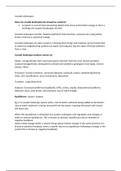Coastal landscapes:
How can coastal landscapes be viewed as systems?
• A system is a set of interconnecting objects that store and transfer energy to form a
working unit (coastal landscapes do this)
Coastal landscapes transfer material (sediment from beaches, estuaries etc) using either
kinetic, thermal or potential energy.
Coastal landscapes are open systems, meaning that energy and material can be transferred
to and from neighbouring systems (as inputs and outputs). Eg; the input of fluvial sediment
from a river.
Coastal landscape systems consist of;
Inputs- energy (kinetic form wind and waves, thermal from the sun), human activities
(coastal management), atmospheric (climate and weather), geological (rock type), marine
(waves, tides)
Processes- erosion (attrition, corrosion/abrasion, hydraulic action), weathering (freeze-
thaw, salt crystallisation, mass movement), deposition
Transfers- Long Shore Drift
Outputs- Erosional landforms (headlands, cliffs, arches, stacks), depositional landforms
(beaches, spits, sand dunes, salt marshes), loss of wave energy
Equilibrium- inputs= outputs
Eg; In a coastal landscape system when, rate of which sediment being added to the beach=
rate at which sediment is being removed from the beach; meaning the beach will remain
the same size.
When this equilibrium is disturbed, the system undergoes self-regulation and changes in
order to restore equilibrium. This is known as dynamic equilibrium and an example of
negative feedback.
(when initial change within a system brings about further change in the same direction it is
known as positive feedback, when a system returns to equilibrium following a change in the
system this is known as negative feedback).
,Sediment cells-
Are a stretch of coastline and its nearshore area, where the movement of sediment, sand
and shingle is largely self-contained
• There are 11 large sediment cells, around England and Wales (Lands End- The River
Severn)
• Sediment cell boundaries are determined by the topography and shape of the
coastline, eg; large physical features such as Lands’ End act as huge natural barriers
that prevent the transfer of sediment to adjacent cells
• They are regarded as closed systems, however in reality they are not entirely closed
due to varying wind directions and tidal currents etc meaning sediment transferring
to neighbouring cells is inevitable
• Cells contain many sub-cells as well
Physical factors that influence coastal landscape systems-
Winds, Waves, Tides, Geology
Winds (Aeolian);
• Provide the main source of energy (kinetic), which is transferred into the oceans due
to the frictional drag of winds moving across the ocean surface
• Onshore winds (sea to coast) generate waves that erode the coastline
• Oblique winds (at an angle), result in waves hitting the coastline obliquely and
longshore drift
• The absence of wind leads to deposition
Waves;
Form due to the frictional drag of wind over the surface creating small ripples which grow as
the wind blows behind it.
Wave energy-
Wave energy formula=
• Increase in energy when there is a higher wind speed and longer fetch
• Possess potential energy (position above the wave trough) and kinetic energy
(motion of water within the wave)
• In the open sea there is no actual movement of water, just a movement of energy
• The relationship between wave height and energy is non-linear, eg; Atlantic waves
are eight times higher than English Channel waves, however have 70 times more
energy (showing that wave height is a more important factor than wave period in
determining wave energy)
, Wave anatomy-
Breaking waves-
• Start to break when the sea floor depth is half the size of the wave (as the deepest
circling molecules come in contact with the sea floor)
• Friction with the sea floor causes the wave to slow down, the deepest part more
than the top, causing the crest to advance ahead of the base
• When water depth is less than 1.3x wave height, the wave topples over and breaks
against the shore
• Water then moves up the beach as swash, slowing down the further it travels due to
friction and the uphill gradient of the beach. When swash has no more available
energy to move up the beach it is drawn back down as backwash (comes down
perpendicular to the beach under the force of gravity)
Breaking waves-
1. Spilling, steep waves breaking onto gently sloping beaches, water spills gently
forwards as the wave breaks
2. Plunging- Moderately steep waves breaking onto steep beaches, water plunges
vertically downwards as the crest curls over
3. Surging, low angle waves breaking onto steep beaches, the wave slides forwards and
may not actually break





